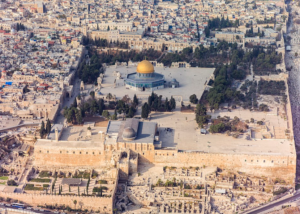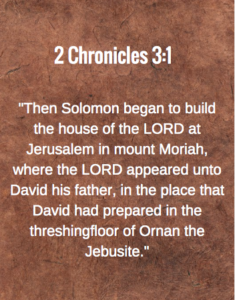The Biblical Case for the Location of the Temple: Part 3
 Out of the city of David?
Out of the city of David?
A verse that is often quoted by critics which they believe refutes the idea that Solomon’s temple was built in the city of David is 2 Chronicles 5:2 (Also 1 Kings 8:1):
Then Solomon assembled the elders of Israel, and all the heads of the tribes, the chief of the fathers of the children of Israel, unto Jerusalem, to bring up the ark of the covenant of the Lord out of the city of David, which is Zion.
The inference they make from this verse, (taken out of context by the way), is that it had to be taken out of the city of David in order to be brought into the newly built Solomon’s Temple in another location. However, I don’t think they fully realize the implications of this interpretation, because the Bible makes it very clear that the city of David and Jerusalem are two names for the same geographical location. [See: The Biblical Case for the Location of the Temple, Part 1] So, if it was taken out of the city of David, it was taken out of Jerusalem making the Temple to have been built OUTSIDE of Jerusalem which contradicts a multitude of Scriptures throughout the Bible which say that the temple was in Jerusalem.
How did the ark get in the city of David?
In 1 Samuel 4, the Elders of Israel had the ark brought from Shiloh to where they had set up camp to go against the Philistines in battle. Since God had not instructed them to do that, the Philistines massacred the Israelite army and the Philistines captured the ark.
The Philistines put the Ark in the house of Dagon, the fish god, and some unpleasant events followed during the seven months they were in possession of it, so when they had enough, the Philistines put it on a cart and sent it off on its own. It went to Beth-shemesh which then sent messengers to the inhabitant of Kirjath-jearim to tell them to come and get the ark. [1 Samuel 5 and 6]
The men of Kirjath-jearim then came and got the ark and brought it to the house of Abinadab and sanctified his son Eleazar to keep the ark. It stayed there for twenty years, during which the house of Abinadab was greatly blessed. [1 Samuel 7:2]
Hearing how well the house of Abinadab had done with the ark located there, David tried to move the Ark to the city of David, but he didn’t do it properly and Uzziah was killed when he touched the ark. So David was afraid to bring it to the city. It remained with the family of Obed-edom for three more months. [2 Samuel 6 and 1 Chronicles 13]
After awhile David decided to try again, only this time he did it correctly. He first prepared a place for the Ark and pitched a tent for it. He gathered all Israel together to Jerusalem to bring up the Ark unto the place that he had prepared for it. He did it right this time and had the Levites bring it to the city of David. [1 Chronicles 15 ]
They brought the Ark and set it in the midst of the tent that David had pitched for it, and they offered burnt-sacrifices and peace-offerings before God. [1 Chronicles 16:1.]
David assigned Asaph and his brethren to minister by the ark (1 Chronicles 16:37) and Zadok the priest and his brethren stayed at the Tabernacle of the Congregation (which Moses had made in the wilderness) in the high place that was at Gibeon which was approximately 6 miles away. (1 Chronicles 16:39)
Both accounts in 2 Samuel 6:12 and 1 Chronicles 15:29; 16:1 state that the Ark was brought into the city of David and set in its place in the tent that David had prepared for it.
This makes it very clear that the ark indeed was kept in the city of David. 2 Chronicles 1:4 summarizes the entire event but states that David pitched a tent for it AT JERUSALEM:
But the ark of God had David brought up from Kirjath-jearim to the place which David had prepared for it: for he had pitched a tent for it AT JERUSALEM.
Years later, when Solomon was king, he went to Gibeon to sacrifice there and gave a thousand burnt-offerings on the altar. That night, while still at Gibeon, he had the famous dream where God told Solomon to ask him for anything, and Solomon asked for wisdom to rule the people of Israel. When Solomon woke up “he came to JERUSALEM, and stood before the ark of the covenant of the LORD and offered up burnt-offerings, and offered peace-offerings, and made a feast to all his servants.” (1 Kings 3:15)
The above verses show that the city of David and Jerusalem were one in the same and that the Ark was located there. [in Jerusalem / the city of David]
So, why did they have to take the ark out of the city of David / Jerusalem?
The answer is found by reading the verses that follow in 2 Chronicles 5:1-7 [also 1 Kings 8:1-6.]
Then Solomon assembled the elders of Israel, and all the heads of he tribes, the chief of the fathers of the children of Israel unto Jerusalem, to bring up the ark of the covenant of the LORD out of the city of David, which is Zion. [2 Chronicles 5:2]
First, all of the men of Israel and the elders of Israel assembled for the feast which was in the seventh month called Ethanim, now known as Tishri. [verses 3 & 4] and once assembled the Levites picked up the Ark and took it out of the city of David / Jerusalem in the correct manner and walked approximately 6 miles to the high place at Gibeon where the Tabernacle of the Congregation that was made in the wilderness was located, and they gathered up the Tabernacle and all the holy vessels that were in the tabernacle [verse 5] and the whole processesion went to a location [not specified*] where there was room for the whole group including all of the sheep and oxen they sacrificed which could not be told nor numbered for the multitude. [verse 6] They could not gather inside of the city of David / Jerusalem because it was only a 12-acre piece of land which would have houses and other buildings needed for a city.
Then, after all of the sacrifices were concluded, “the priest brought in the ark of the covenant of the LORD unto his place, to the oracle of the house into the most holy place, even under the wings of cherubim.” [verse 7]
Solomon’s Temple was built in the city of David / Jerusalem, over the threshing floor that David purchased from Ornan the Jebusite, which makes it impossible for it to have ever been on the “so-called” Temple Mount, because it would have been outside of the geographical location called Jerusalem.
_____________________
*As to the unspecified location of the sacrifices, I think it is natural to assume that since the Temple was completed, they would sacrifice on the altar provided in the Temple. The people would all be gathered in the Kidron Valley, but since the Bible doesn’t specify, we can only make educated guesses.

